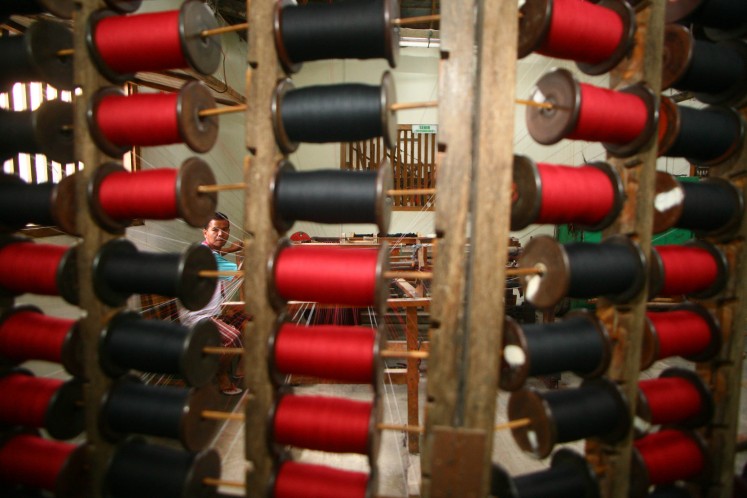Popular Reads
Top Results
Can't find what you're looking for?
View all search resultsPopular Reads
Top Results
Can't find what you're looking for?
View all search resultsThe kick of Minahasa cuisine
Biapong served with milk coffeeManado in North Sulawesi has a little bit of everything for everyone from beach bunnies to mountain-goers
Change text size
Gift Premium Articles
to Anyone
Biapong served with milk coffee
Manado in North Sulawesi has a little bit of everything for everyone from beach bunnies to mountain-goers. From the gorgeous views of the deep blue sea and its wildlife in Bunaken National Park to the cozy highlands of Tomohon and Tondano, there is always something to tickle our fancy.
However, the constant blue skies and that faint smell of the sea are much more alluring if we enjoy them accompanied by local cuisine.
There is no doubt that Padang, Javanese and Sundanese food has taken the lead in terms of popularity, but Manadonese cuisine deserves to be in the spotlight. If there is one noticeable consistency within Manadonese cuisine, it’s the spiciness of almost every dish that one comes across.

Dabu-dabu
One particular specialty is the presence of woku, rica-rica or dabu-dabu, which have the equivalent popularity as sambal terasi (chili with shrimp paste) in Sundanese or Javanese eating culture. The Manadonese sambal, however, does not contain fermented shrimp paste. The reason is simple. The region is so rich in seafood that people want totally fresh ingredients in their sambal.
This tasty sambal of Woku comprises red ginger, turmeric, candlenut, red chili pepper, chopped shallots, tomatoes, lemon or citrus leaf, lemon basil leaf and bruised lemongrass that gives it a delicious tang.
Meanwhile, Dabu-dabu consists of chopped red chili peppers, shallots, red and green tomatoes, salt, sugar. Then, these spices are mixed together with calamansi juice or lemon juice. This sambal is a favorite accompaniment of grilled fish.
Manado’s spicy sambal can also go well with meat. The Manadonese are very open in their choice of meats. Before the region converted to Christianity in the early 16th and 17th century, animism was a common ideology. So, to this day citizens are well-accustomed to eating whatever walks on land or flies in the air. Let’s take a look at some of Manado’s spiciest.
Cakalang fufu, or skipjack tuna — the region’s most coveted fish with spicy rica-rica. When you visit Manado, don’t forget to take the fish home to cook with the family. Smoked cakalang on sticks can be found in the city’s roadside stalls on Jl. Ahmad Yani in the Sario district, ready to be packed in cardboard boxes for visitors.
Sate babi, or pork skewers topped with none other than rica-rica. The freshness of this Manadonese sambal makes it a far more flexible condiment for other types of meat besides fish.
Dabu-dabu is usually prepared separately in generous amounts so that people are free to scoop it up to elevate whatever dish they choose.
Gohu is Manado’s version of asinan Bogor (pickled vegetables). Refreshing dishes like this are of pickled vegetables or fruit, such as young papaya. You are likely to see a handful of Manadonese from all walks of life savoring this dish morning and night. However, it can get quite spicy despite the underlying sweetness from the brown sugar.
Paniki, or spiced bat. The broth to season the meat of our nocturnal friend is coconut milk, accompanied by rich spices such as ginger, candlenut, turmeric and lemongrass to name a few. Still, the spicy kick is the result of cayenne pepper, though it might not look that menacing in a photo.
So, to close off our spicy adventure, the Manadonese still know how to conjure up some comforting selections to ease our burning tongues. Steamed buns in Manado are known as biapong, with various fillings such as red-bean and pork that one can enjoy over coffee and tea. A very popular choice at which to eat these buns is Kedai Topas, located in the South Minahasa regency of Amurang.
Our final dessert, is es kacang. Es kacang can be served in different ways depending on which food stall you decide to visit that day. The nuts used can be either groundnuts or red kidney beans. Finally, shaved ice brings the cooling sensation that we seek, and it can either be topped with liquid brown sugar or condensed milk with bright syrup.
— Photos by Cemara Dinda
_____________
— The writer is an intern at The Jakarta Post










